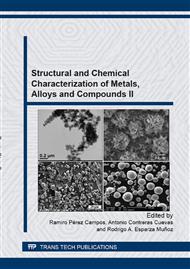[1]
R. Galvan-Martinez, R. Orozco-Cruz, G. Galicia-Aguilar, A. Contreras, J. Mendoza-Flores, J. Genesca-Llongueras, Corrosion study of pipeline carbon steel in sour brine under turbulent flow conditions at 60°C, Afinidad 562 (2013)124-129.
DOI: 10.5772/23065
Google Scholar
[2]
R. Galvan-Martinez, J. Mendoza-Flores, R. Duran-Romero y J. Genesca-Llongueras, Effects of turbulent flow on the corrosion kinetics of X52 pipeline steel in aqueous solutions containing H2S, Materials and Corrosion 55 (2004) 586–593.
DOI: 10.1002/maco.200303776
Google Scholar
[3]
R.H. Hausler, Contribution to the understanding of H2S Corrosion, Corrosion/2004, Paper 04732, NACE International, Houston, TX, 2004.
Google Scholar
[4]
S. Arzola-Peralta, J. Mendoza-Flores, R. Duran-Romero, J. Genesca, Cathodic kinetics of API X70 pipeline steel corrosion in H2S containing solutions under turbulent flow conditions, Corros. Eng. Sci. Tech. 41 (2006) 321-327.
DOI: 10.1179/174327806x139117
Google Scholar
[5]
K.L.J. Lee, S. Nesic, EIS investigation of CO2/H2S corrosion, Corrosion/2004, Paper 04728, NACE International, Houston, TX, 2004.
Google Scholar
[6]
Y.P. Asmara, M.C. Ismail, Study Combinations Effects of HAc in H2S/CO2 Corrosion, Journal Applied Sciences 11 (2011) 1821-1826.
DOI: 10.3923/jas.2011.1821.1826
Google Scholar
[7]
D. Cabrera de la Cruz, R. Galvan-Martinez, R. Orozco-Cruz, R. Torres-Sanchez, and A. Contreras, Electrochemical Characterization of the Stainless Steel Corrosion Immersed in Seawater under Turbulent Flow Conditions by Electrochemical Noise, Mater. Res. Soc. Symp. Proc. 1275 (2010) 65-71
DOI: 10.1557/proc-1275-s3-47
Google Scholar
[8]
R. Cottis, S. Turgoose, Electrochemical Impedance and Noise, Corrosion Testing Made Easy Series, Barry C. Syrett Series Editor, NACE, Houston, TX, 1999.
Google Scholar
[9]
A. Legat, V. Dolecek, Corrosion Monitoring System Based on Measurement and Analysis of Electrochemical Noise, Corrosion 51 (1995) 295-300.
DOI: 10.5006/1.3293594
Google Scholar
[10]
B. Joseph, X.D. Dai, R.L. Motard, D.C. Silverman, Improved Discrimination of Electrochemical Noise Signals Using Wavelet Analysis, Corrosion 57 (2001) 394-403.
DOI: 10.5006/1.3290363
Google Scholar
[11]
K. Hladky, J.L. Dawson, Corros. Sci. 22 (1982) 231-237.
Google Scholar
[12]
ASTM Designation: G 199 – 09, Standard Guide for Electrochemical Noise Measurement, ASTM International, West Conshohocken, PA, 2009.
Google Scholar
[13]
P.R. Roberge, S. Wang, R. Roberge, Stainless Steel Pitting in Thiosulfate Solutions with Electrochemical Noise, Corrosion 52 (1996) 733-737.
DOI: 10.5006/1.3292065
Google Scholar
[14]
K. Hladky, J.L. Dawson, Corrosion Monitoring using Low Frequency Electrochemical Noise, KH Design and Development (Electrochemical Corrosion Measurement and Control Consultancy). http://www.khdesign.co.uk/acrobat/paper3.pdf
Google Scholar
[15]
F. Mansfeld, C.C. Lee, Comparison of electrochemical noise and impedance data for passive systems, Corrosion/99, Paper 99195, NACE International, Houston, TX, 1999.
Google Scholar
[16]
D.A. Eden, Electrochemical noise - the first two octaves, Corrosion/98, Paper 98386, NACE International, Houston, TX, 1998.
Google Scholar
[17]
R.A. Cottis, Interpretation of electrochemical noise data, Corrosion 57 (2001) 265-285.
DOI: 10.5006/1.3290350
Google Scholar
[18]
F. Mansfeld, Z. Sun, Technical note: Localization index obtained from electrochemical noise analysis, Corrosion 55 (1999) 915-918.
DOI: 10.5006/1.3283926
Google Scholar
[19]
G.I. Ogundele, W.E. White, Some Observations on Corrosion of Carbon Steel in Aqueous Environments Containing Carbon Dioxide, Corrosion 42 (1986) 71-78.
DOI: 10.5006/1.3584888
Google Scholar
[20]
F.H. Meyer, O.L. Riggs, R.L. Mcglasson, J.D. Sudbury, Corrosion of mild steel in H20 environments, Corrosion 14 (1958) 109-115.
DOI: 10.5006/0010-9312-14.2.69
Google Scholar
[21]
G. Chen, Z. Sun, X. Zhou, Oxidation of Intermetallic Alloys in Ti-Al-Nb Ternary System, Corrosion 48 (1992) 939-946.
DOI: 10.5006/1.3315897
Google Scholar
[22]
R.A. King, D.S. Wakerley, Brit. Corros. J., Corrosion of Mild Steel by Ferrous Sulphide 8 (1973) 41-45.
DOI: 10.1179/000705973798322521
Google Scholar
[23]
C. L. Cahill, L. G. Benning, H. L. Barnes, J. B. Parise, In situ time-resolved X-ray diffraction of iron sulfides during hydrothermal pyrite growth, Chemical Geology 167 (2000) 53-63.
DOI: 10.1016/s0009-2541(99)00199-0
Google Scholar
[24]
G. Wächtershäuser, The cradle chemistry of life: On the origin of natural products in a pyrite-pulled chemoautotrophic origin of life, Pure Appl. Chem. 65 (1993) 1343-1348.
DOI: 10.1351/pac199365061343
Google Scholar
[25]
A. Anderko, R.D Young, simulation of CO2/H2S corrosion using thermodynamic and electrochemical models, Corrosion/99, Paper 99031, NACE International, Houston, TX, 1999.
Google Scholar
[26]
P.H. Tewari, A.B. Campbell, Dissolution of iron during the initial corrosion of carbon steel in aqueous H2S solutions, Can. J. Chemistry 57 (1979) 188-196.
DOI: 10.1139/v79-031
Google Scholar
[27]
D.W. Shoesmith, Taylor, Peter, M .G. Bailey, D.G. Owen, The formation of ferrous monosulphide polymorphs during the corrosion of iron by aqueous hydrogen sulphide at 2l°C, J. Electrochem. Soc. 127 (1980) 1007-1015.
DOI: 10.1149/1.2129808
Google Scholar
[28]
H. Vedage, T.A. Ramanarayanan, J.D. Mumford, S.N. Smith, Electrochemical growth of iron sulfide films in H2S-saturated chloride media, Corrosion 49 (1993)114-121.
DOI: 10.5006/1.3299205
Google Scholar


